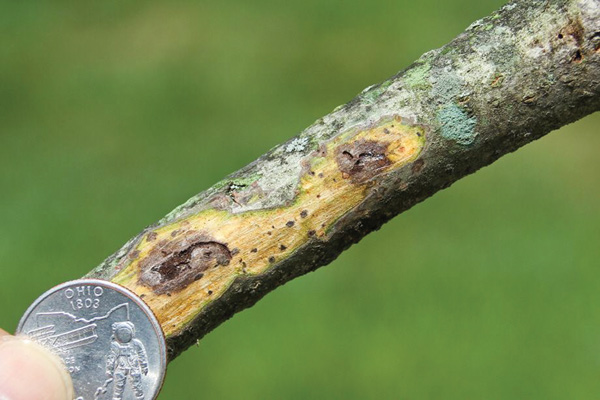Ohio’s newest invasive species kills walnut and butternut trees Thousand cankers DISEASE


Damage done by the walnut twig beetle is seen above. Below, the beetle is seen on a penny. Note: Photos are not to scale.
Ohio’s newest invasive species kills walnut and butternut trees
Thousand cankers DISEASE
By KATHY SMITH
OSU Ext. state program director-forestry
In August 2013, Ohio added another invasive species to its growing list — thousand cankers disease (TCD) found in Butler County.
What is TCD? The fungus, Geosmithia morbida, causes walnut mortality and is carried by the walnut twig beetle (WTB) Pityophthorus juglandis as it bores into the tree.
This fungus causes thousands of small cankers to form under the bark and eventually they coalesce in the cambium layer of the tree, causing the supply of nutrients and water to these branches and stems to be cut off.
Which trees are susceptible to TCD? Black walnut (Juglans nigra) and butternut (Juglans cinerea) are very susceptible, while pecan (Carya illinoinensis) and shagbark hickory (C. ovata) are immune.
Visual symptoms include yellowing of foliage and thinning in the upper crown of the infested tree.
Yellowing foliage on black walnut in late summer is nothing new to anyone who is familiar with walnut. However, thinning of the upper crown with eventual dieback in that crown are symptoms that should make owners of a walnut tree question just what is going on with the tree.
It is important to note that to date, while there are monitoring traps scattered around the state, only two locations in Butler County have resulted in walnut twig beetle finds.
As with many of these non-native insect and disease issues on our trees, human movement of wood products (firewood, logs etc.) seems to be a major player in the spread of this disease, so limit movement of these potential carriers.
So far there are no recommended chemical treatments for either the twig beetle or the fungus.
Treatments that would target either of these entities end up being present in the nutmeat of the walnut (a potential food product) and therefore are not a viable means of dealing with TCD.
When something appears to be unusual with your trees, ask questions.
The Great Lakes Early Detection Network (GLEDN) smartphone app is available as a free download (http://go.osu.edu/GLEDN) and has images on TCD that you can use when looking at suspicious trees. If you believe someone needs to take a closer look, snap a picture with your phone and upload it using the app.
For more information on TCD, Ohio State Extension has a fact sheet (Thousand Cankers Disease, HYG- 3313-13). There is also a great regional website available at http://thousandcankers.com.
 43
43
